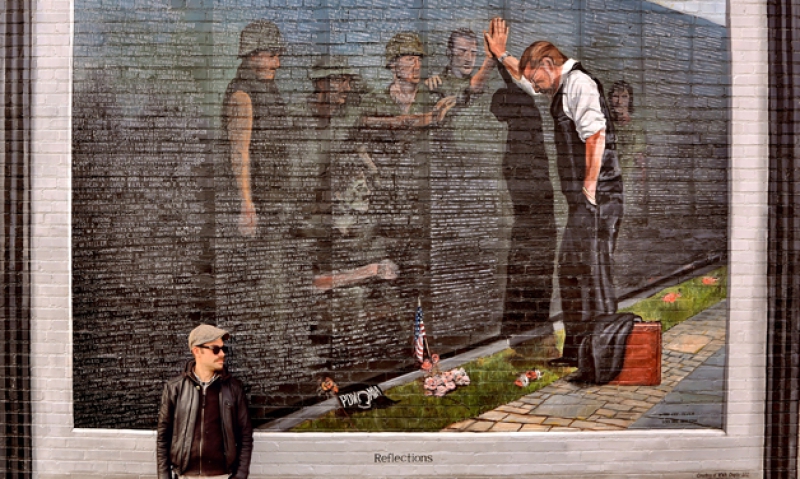
Washington Conference panel urges local communities to help returning servicemembers connect the dots at home.
David DuBois remembers trying to explain his work to a young soldier - a member of the so-called "millennial generation." He told him to check out the Office of Wounded Warrior Care & Transition Policy's Web site. The soldier looked at DuBois and politely explained that Web sites are for old people with enough time to sit down and use a computer.
"The millennial generation is an on-demand society," said DuBois, a former American Legion department commander who now directs wounded-warrior and transition-assistance operations for the Department of Defense. "Seventy percent of millennials sleep with their phones," he explained. "They do not use phones to make phone calls so much anymore."
DuBois and three other military-to-civilian experts told The American Legion Economic Commission on Monday that networking - through electronic social media via cell phones, as the new generation prefers, or in person, as with the Marine for Life program - is critical to help newly discharged veterans restart their lives, especially if they come home with service-connected disabilities.
"We've got to find a way so that every returning servicemember gets red-carpet networking," said DuBois, a 2001 graduate of American Legion College. "To welcome all of them back, networking is the absolutely critical need."
The panel discussion, coordinated by the Legion's Heroes to Hometowns program during the 50th Washington Conference this week, examined transition assistance from multiple angles, all of which rely on making connections among communities' returning servicemembers.
"Two million OIF/OEF veterans are enrolling in college," said Stacie Hitt, director of "Operation Diploma" at Purdue University's Military Family Research Institute. "Twenty five percent will have a hidden disability, and 15 percent will have a clear disability. That's about 800,000 students with some kind of disability."
Her program engages the entire community - schools, clergy, veterans groups and others who come into contact with transitioning military families - to address concerns faced by those who have stepped off the military base and onto college campuses.
One of her program's goals is to provide resources for institutions in Indiana to better understand and serve transitioning families. Operation Diploma, she explained, provided $275,000 in grants for colleges that strengthened their veteran-transition programs last year, and $1.1 million will be awarded this year. While she said Indiana schools that accept GI Bill benefits are making headway in their transition-assistance programs, gaps exist. Classroom policies that deny calculators or electronic organization devices to veterans who have suffered from traumatic brain injuries, for instance, need to be rethought, she said. She also explained that with the amount of veterans coming home with some kind of disability, the number of campuses with veteran disability coordinators needs to rise from the current level of 72 percent.
Col. Gregory A.D. Boyle, commanding officer of the U.S. Marine Corps' Wounded Warrior Regiment at Quantico, Va., told members of the Economic Commission that "the goal is not for DoD to push the Marine out of the service but for the community to pull the Marine in."
The USMC's transition assistance program, which is structured around the Marine for Life philosophy and includes a 24/7 call center, is a model among the service branches.
"Every day, I work with the other branches, and we are all heading in the same direction," he said. A key component of the program, he explained, is outreach before and after discharge, including "a 16-page checklist to prepare them."
He said that by the time a wounded warrior leaves Quantico, claims paperwork will have already been completed; TRICARE benefits will be managed, and resumes will be written. "We prepare them for life," Col. Boyle said. "It's the Marine for Life way."
And once a Marine is home, local mentors - often former Marines themselves or members of veterans service organizations like The American Legion - network with the newly discharged veterans to help them adjust.
Roger Neppl, director of military programs for the U.S. Olympic Committee's Paralympic Division, explained how local community networks can help newly discharged wounded warriors restore self esteem, avoid depression and improve their health by getting them involved with adaptive sports programs. "If, in fact, you have an injured servicemember in your community, you can help by connecting the dots," Neppl said. "Link people with local sports clubs, parks and recreation departments that have adaptive training programs, colleges and universities and even K-12 public education systems can help. Just connect that person."
DuBois - who recently led a work group on a massive update of the federal TAP (Transition Assistance Program) that will better serve the needs of National Guard and Reserve components - said a new online directory provides a comprehensive listing of programs and services to help troops in transition. The site - www.nationalresourcedirectory.gov - "is a huge resource system for the federal, state and local level. If your organization's program is not there, there is a mechanism to self-nominate to be included."
American Legion Heroes to Hometowns program coordinator Andrew Tramontana told the commission that in order for any of these efforts to help transitioning troops to be successful - whether it's on campus, over coffee, on a ski slope, in a swimming pool or as a friend on a social media site - "we have to do better. Too often, the request for assistance that we receive comes too long after the fact. We have to ascertain information and needs at the grass-roots level. We have to communicate, and we have to collaborate."
Heroes to Hometowns is a nationwide program that connects American Legion posts and members with returning wounded, sick or injured servicemembers in transition. For more information, visit www.legion.org/heroes.
- Troops


